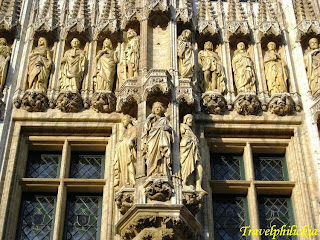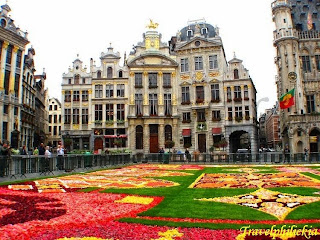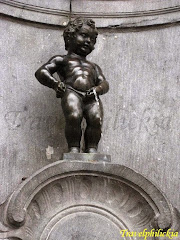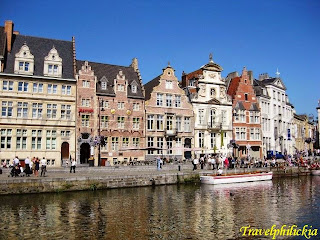Took train at 1637 hours from Neuchâtel and we reached Geneva Airport at 1752 hours. The return SBB train tickets cost CHF 44 with validity of 10-days. After a long wait at the transit area in the Airport, we boarded our flight EZY 1537. Glad that the flight departed and arrived on time.
Once cleared our customs at Brussels Airport, we then took the train at Airport Train Station to Brussels Central Station. The cost of a single trip was EUR 5.10 and journey was about 30-mins to reach the Central Station. Perhaps we were no familiar with the location of the Bruegel Hostel initially; it took us almost 15-mins to search for it at night. After checked-in the hostel and some wash-up, I finally managed to have a good rest.
Day Two
We woke up in the morning at about 7 am to have our early breakfast. The reason was to take good photographs of the Flower Carpet before our day tour. From the hostel, it took us about 10-mins walk to the Grand-Place.
Grand-Place
The Grand-Place, or Grote Markt in Dutch, is a central square in Brussels measuring 68-metres by 110-metres. The square is surrounded by opulent guildhalls and two larger edifices: the city's Town Hall and the Breadhouse building which now houses the Brussels City Museum.
On the south side of the square stood the Brussels Town Hall (photos below) built from 1402 to 1420. Standing at 96-meters tall, the tower is capped by a 3-meters golden statue of Saint Michael slaying a demon.

The facade of this building is decorated with numerous statues representing nobles, saints, and allegorical figures (photos below). However the present sculptures are reproductions, and the older ones are in the city museum in the "King's House" across the square.

Opposite the Brussels Town Hall is the Museum of the City of Brussels (photos below). Known as Musée de la ville de Bruxelles in French or Museum van de Stad Brussel in Dutch, the museum was built inside the Masion du Roi, known better by the Dutch speakers as the King's House or Broodhuis, the Bread House. One of highlights in this museum is the display of hundred customs of Mannekin Pis.

On the south of the square stood the baroque style houses (left photo below). From right to left: Le Cygne, L'Arbre d'Or, La Rose, and Le Mont Thabor. One of the noticeable houses is the Golden Tree or L'Arbre d'Or in French. Located at number 10 of the Grand-Place, this building is also known as the House of the Brewers, or Maison des Brasseurs in French, where the equestrian statue of Prince Charles Alexander of Lorraine stood on the top of the building.
At number 9 of the Grand-Place is the House of Swan (right photo below), or Maison du Cygne in French. No guessing is required on why the building was named so.

On the west of the square stood another baroque style houses (left photo below). From right to left: Le Roy d'Espagne, La Brouette, Le Sac, and La Louve.
The House of King of Spain (right photo below), or Le Roy d'Espagne in French, is located at number 1 of the Grand-Place. The center of the building is decorated with a remarkable sculpture depicting the triumph of Charles II of Spain, surrounded by trophies and chained slaves. The lantern tower is adorned with pilasters and the dome decorated with an oculus, fire pots and a female statue trumpeting.

The House of Wheelbarrow (left photo below), or La Maison de la Brouette in French, is located at number 2 and 3 of the Grand-Place. The facade is crowned by an ornate gear incorporating a niche with the statue of St. Gilles accompanied by a doe and topped with a large seashell.
The House of Wolf (right photo below), or Maison de la Louve in French, is located at number 5 of the Grand-Place. The facade is crowned by a triangular pediment archer representing Apollo killing the serpent Python. This pediment carries a pinion topped the Phoenix rising from the ashes occurring flames, symbol of the reconstruction of the house in 1691 after the fire of 1690.

The Grand-Place is the most important tourist destination and most memorable landmark in Brussels. Although voted as the most beautiful square in Europe, personally I regard the Grand-Place to be the most beautiful square in the world.
 |
The Grand-Place was listed as an UNESCO World Heritage Site in 1998. |
Once every two years in August, an enormous Flower Carpet will be set up in the Grand-Place lasting for only three days. A million colorful begonias are set up in patterns, and the display covers a full 24-meters by 77-meters, totaling an area of 1,800 square meters (photos below).


On the other two corners of the carpet, there was the stylized image of the yellow and blue iris which is the emblem of Brussels (left photo below). In the very center, the elegant EU logo was displayed at three different angles on the outer ring of the fountain (right photo below).

Mannekin Pis
Manneken Pis, in fact is Dutch which literally means "Little man Pee" or le Petit Julien in French. It is a landmark small bronze sculpture in Brussels, depicting a naked little boy urinating into a fountain's basin (photos below). Designed by Hiëronymus Duquesnoy the Elder, it was put in place in 1618 or 1619. Traditionally the statue is dressed in costume several times each week, but I was lucky to see the original Manneken Pis without any clothes.
This famous statue is located at the junction of Rue de l'Étuve/Stoofstraat and Rue du Chêne/Eikstraat, just few hundred meters from the Grand-Place.

Ghent and Bruges Day Trip
Booked this day trip via the Viator few weeks in advance before our departure. The cost of this trip was USD 54.60 per person, which included entrance fees, transportation in air-conditioned coach but excluded lunch and drinks.
Though we arrived early near the Grand-Place, we still could not find the specific tour agency to report as the address was rather confusing. Finally we managed to find the tour agency (left photo) but were 5-mins late. Initially we wanted to check if we could join other tour, but luckily the tour agency, out of good will, drove us to the main assemble area and we were just in time to depart.
After about an hours' drive, together with the tour group, we arrived at Ghent.
Ghent
Ghent, or Gent in Dutch or Gand in French, is a city and a municipality located in the Flemish Region of Belgium. It is the capital and largest city of the East Flanders province. Much of the city's medieval architecture remains intact and is remarkably well preserved and restored.
Friday Market Square
First sight at Ghent was the Friday Market Square. Also known as Vrijdagmarkt in Dutch, this market square is one of Ghent's large city squares. Located in the historical center of Ghent, a number of architecturally interesting buildings from the 18th century can be found on the Friday Market Square. One such building is the Bond Moyson Building (left photo below). In the middle of the square is a statue of Jacob van Artevelde (right photo below).


Lys Canal
One of the most scenic sights in Ghent is the Houses on both sides of Lys Canal (photos below).

Gravensteen
The Gravensteen, which literally translated as "Castle of the Counts" in Dutch, is a castle built in 1180 (photos below). The castle served as the seat of the Counts of Flanders until it was abandoned in the 14th century. Only in 1885 that the castle was bought by the City of Ghent where renovation began. Now it has become a tourist attraction.

Old Post Office
Located in Corn Market, the Old Post Office (left photo below) is a building in neo-Gothic and neo-Renaissance style built between 1898 and 1910 for World Fair in 1913. Its facades are decorated with coats of arms and busts of 23 former European heads of state. The most impressive part of the building is the clock tower rising 52-meters high (right photo below) which stood above all buildings.

Mason's Guild Hall
Opposite St. Nicholas Church is the Masons' Guild Hall, or Metselaarshuis in Dutch. On top of the stepped gable stood six dancers that seems to be turning merrily with the wind (left photo below). More importantly, this building is the real Mason House from the 16th century. Due to the World Fair in 1913, the original house was hidden by some ugly walls and since then forgotten. Only until a renovation work in 1976 that this Masons' Guild Hall was rediscovered by accident.
St. Nicholas' Church
St. Nicholas' Church, or Sint-Niklaaskerk in Dutch, is one of the oldest and most prominent landmarks in Ghent (right photo below). Built in the early 13th century, construction continued through the rest of the century in the local Scheldt Gothic style.

Belfry of Ghent
The Belfry of Ghent (left photo below) is one of three medieval towers that overlook the old city center of Ghent, the other two are St. Bavo Cathedral and St. Nicholas' Church. Standing at an impressive height of 91-meters, it is the tallest belfry in Belgium (right photo below).

Equally remarkable is the elaborate stone and marble naves inside the cathedral (photos below).

 The Belfry of Ghent together with its attached buildings belongs to the set of belfries of Belgium and France and are listed as World Heritage Sites by UNESCO in 1999.
The Belfry of Ghent together with its attached buildings belongs to the set of belfries of Belgium and France and are listed as World Heritage Sites by UNESCO in 1999.Korenlei
The Korenlei is a street in the historic city center of Ghent (photos below), and is considered the oldest part of the city. The street grew from the 11th century together with the trading along these quays. The current buildings are still a remnant of time, though several buildings were adapted in the 18th and 19th centuries.

We departed for Bruges after a short free and easy time at Ghent.
Bruges
Bruges, or Brugge in Dutch or Brügge in German, is the capital and largest city of the province of West Flanders.
 Bruges has most of its medieval architecture intact, and its historic city center has been listed as an UNESCO World Heritage Site since 2000.
Bruges has most of its medieval architecture intact, and its historic city center has been listed as an UNESCO World Heritage Site since 2000.Minnewater
Minnewater is the first sight that we saw at the entrance to the Bruges (left photo below). Because of the idyllic surroundings it is mostly referred to as the 'Lake of Love', and interestingly the word 'Minne' means 'Love' in Dutch. In fact, Minnewater is only a canalized lake.
There are always plenty of swans at the lake (right photo below), and coincidentally swan is one of the symbols for Bruges.

'Ten Wijngaerde' Beguinage
Beguines were 'religious women', windows or spinsters who wised to live an independent but committed life outside the recognized orders with their vows of fidelity and poverty. They organized themselves in self-supported 'cities of peace', revealing architectural and urban qualities. To this day, the Bruges beguinage, with its central courtyard lined with trees and side streets, retains a religious and social function (photos below).
 This site was listed by UNESCO as World Heritage Site, together with 12 other Flemish beguinages, in 1998.
This site was listed by UNESCO as World Heritage Site, together with 12 other Flemish beguinages, in 1998.
Lunch at Brasserie Vivaldi Restaurant
As lunch times approached, our tour guide brough us to Wijingaardstraat street (left photo below) and recommended this Brasserie Vivaldi Restaurant to us (right photo below).

The restaurant was rather packed with customers during lunch (left photo below). To start off, we each had a Belgium Beer – Leffe (right photo below). Taste was smooth for the beer, and the cost was EUR 6.50 for a medium glass.

We also ordered Moules-frites to share. In French, Moules means mussels while frites means fries. Moules-frites is the national dish of Belgium. Traditionally they are served in a large steaming pot of savory broth with a side Belgian frites.
It is claimed that fries originated in Belgium. The fries are cut in defined sizes and double-fried to maintain its crispiness outside but soft inside. As for the mussels consumed in Belgium, most of them come from the North Sea, off the northern coast of the Netherlands. I liked the crispy fries (left photo below) and the taste of the mussels very much (right photo below). Cost of this Moules-frites was EUR 17.50.

Bruges Laces
Bruges made bobbin lace in the late 17th and early 18th centuries, and the name of Bruges is given to a lace of a scrolling character. During this period of renaissance and enlightenment, the making of lace was firmly based within the domain of fashion. We were lucky to witness the making of Bruges Laces during our trip (left photo below). On details, it can be shocking that a simple lace design could use more than 40 threads (right photo below).

A large lace work could be seen along the river bank illustrating the map of Bruges City (left photo below). Even the patterns for river and land could be so finely woven (right photo below).

Old St. John's Hospital
Located opposite the Church of Our Lady, Old St. John's Hospital (photos below) is one of the oldest surviving hospital buildings in Europe. Built in 11th century, today the hospital complex holds the popular Hans Memling museum, as well as hospital records and medical instruments.

Church of Our Lady
The tower of Church of Our Lady reaches 122.3-meters tall in height (left photo below), making it the second tallest brickwork tower in the world. The ribbed vaulting of the Church of Our Lady can be traced to its Gothic roots, while the top of the columns in the nave are decorated with the 12 Apostles (right photo below).

To the right of the main altar is Michelangelo's Madonna and Child (left photo below). Nicknamed as the Madonna of Brugge, the sculpture was completed in 1504. The oval face of the Madonna resembles that of the artist's more well-known work, the Pietà in St. Peter's Basilica at the Vatican (right photo below). It is thought that the sculpture was meant for an altar in Siena Cathedral, Italy, but was bought by two wealthy cloth merchants from Bruges. This is Michelangelo's only sculpture to leave Italy during his lifetime.

Belfry of Bruges
The Belfry of Bruges, or Belfort, is a medieval bell tower in Bruges. It is one of the city's most prominent building and symbol of Bruges (left photo below). The belfry was formerly a treasury and for municipal archives, and also served as an observation post for spotting fires and other dangers.
To access to the tower, visitors will have to walk through a narrow and steep staircase of 366 steps to the 83-metre high building. To the sides and back of the tower stands the former market hall, a rectangular building only 44-metre broad but 84-metre deep, partially enclose an inner courtyard (right photo below).

Market Square
Located in the city centre, the Market Square covers an area of about one hectare. On one side of the square is occupied by restaurants and shops located in former private houses as well as guild houses (left photo below). On the northern side of the square is the Provincial Court rebuilt in 1887 in neo-Gothic style. The red brick building on the right side of the Provincial Court is the Post Office of Bruges (right photo below).
In 1995 the market square was completely renovated and at same time parking was removed making it a traffic-free area.

Burg Square
Located on the picturesque Burg Square is the Town Hall (left photo below). This building is flanked by an Old Civil Registry and the Basilica of the Holy Blood (right photo below).
On the front façade of the Town Hall are six gothic windows together with 48 niche statues of biblical figures and Counts of Flanders. The original statues were demolished during the aftermath of the French Revolution, and their 19th century replacements have also already been changed for more modern versions. Due to our limited time with the tour group, we could not visit its beautiful interior murals and decorations.
The Basilica of the Holy Blood is a Roman Catholic minor basilica built in 12th century as a chapel for the residence of the Count of Flanders. The basilica is best known as the repository of a venerated phial said to contain a cloth with blood of Jesus Christ, brought to the city by Thierry of Alsace after the 12th century Second Crusade.

Dinner at Palais d'Asie
Located just a few hundred meters from Grand-Place, we decided to have dinner at this Chinese restaurant (left photo below). Perhaps we missed Chinese food during our stay in Switzerland, we had dinner buffet in the restaurant which cost EUR 17.60 per person. There were soup, salads, different meat dishes, pastries and fruits to choose from (right photo below). Taste was acceptable as we could not expect more for Chinese Food, especially in Europe.

Grand-Place at Night
Went back to Grand-Place to take more photographs of its lightings in the night. It was beautiful to see the lights on the flower carpet and the buildings (photos below).


 Posts RSS
Posts RSS




































